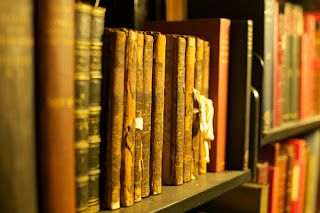 |
| library bookshelf image by BinaryApe, via Flickr |
I began to understand why getting books into the hands of students was so important when I overheard a conversation between two of the teachers in the Department. Gabriela* asked Radu* if what her students told her was true, that he had assigned them all to copy 10 pages from Beowulf the evening before. Initially Radu seemed to deny it, but when Gabriela told him her students didn't get the work she had assigned to them because they said they were all in the library waiting for their turn to copy the pages. At that point Radu admitted that he had given the students that assignment, but he explained that he had made the assignment the week before. He hadn't expected they would all wait until the night before his class to complete it.
That's when I learned that students were not allowed to take books out of the library. If they had to read a book, or copy pages from one, they had to do so in the library. The teachers, however, not only could take books out of the library, they didn't have to return them by any particular date. And since there weren't many books - and certainly not multiple copies of books - there were incentives for the teachers to keep the books for the entire school year, a form of hoarding the information so that no other teacher would have access to it.
The students also often asked to see the books I mentioned. I thought it was a curious request, but when I had the book in hand, it was simple enough to show them.
When I finally visited the university library, I began to understand. At first glance, the library looked very much like any other. There were many tables for students to sit and study or read. There were familiar card catalog racks with those small drawers. And there were shelves of books, but they were not open. Requests for books were turned over to the librarians who would retrieve them, if they could find them.
 |
| card catalog image by dfulmer, via Flickr |
The card catalog drawers were there, but the Dewey Decimal System was nowhere to be seen. The only cards I recall seeing in the drawers were subject cards, not the trio of subject, title, and author cards I was used to. In addition, I understood from Chris that if two copies of the same book were received by the library at different times, the subject cards for the two wouldn't necessarily assign the same subject. It depended on what the librarian cataloging the book thought was the subject. And with foreign language books, the challenge was even greater. The students would use the card catalog to find a book they wanted, write down the details about its location for the request, and hand it over. Since multiple copies of the same book weren't necessarily stored next to one another, there was no foolproof way for students to get their hands on the book they wanted.
One way to improve their chances of getting the book they wanted was to provide a description of the book to the librarian as well. The color of the spine and the height of the book was additional information that could narrow down the possibility of locating the book, especially if the book was on a shelf directly behind the librarian's desk. Books stored on that shelf appeared to me to be organized by size and color - red books on one shelf, blue ones on another, tall books at the left, smaller books in descending sizes to the right.
In the second half of the school year, the Public Affairs Officer of the embassy arranged for an American literary critic to come to Romania as an International Visitor (IV). While in Romania, he and his wife traveled to Iași and other cities with universities and American lecturers in Romania to give special lectures for the students. The IV arranged for multiple copies of five novels to be provided to each of the universities he would visit. And that gave Chris and me some leverage as we repeated the request for a separate English foreign lecturers' room where we could set up our library. We got our room just before the IV. We moved all the books from the small library in the English Department, and added the magazines I brought with me and the multiple copies of the books from our visitor. Between the two of us, Chris and I kept the library open a few hours every day, providing an inviting place for students to come to read magazines or books and even borrow the books.
Of course, I had not considered that the room might have had some additional features, such as listening devices, until many years later.
*a name, not necessarily the right one
No comments:
Post a Comment